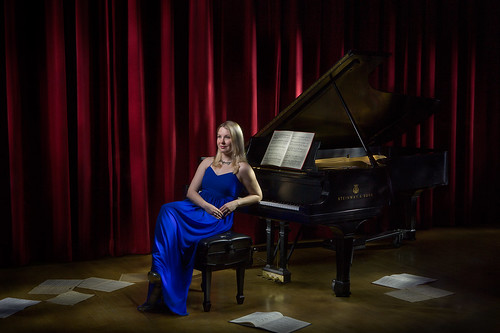
Hanna Lisa Stefansson blends ritualistic performance with dance to create an immersive audio-visual realization as part of her music composition dissertation.
Rather than simulating any specific religion or culture as the backdrop for this ritualistic performance piece, Stefansson, a doctoral student in the Hugh Hodgson School of Music at UGA, is instead inspired by nature and the influence of technology on nature.
In her music composition piece, Stefansson plans for the elemental sounds of earth, water, air, and fire to influence each other through the creation of the “ritual.”
“I’m choosing to highlight natural elemental sounds manipulated with electronics to reflect how technology is changing the natural soundscape. For example, bird calls have morphed due to urbanization, river flows have been altered, and we’re experiencing widespread droughts, causing the absence of the sound of raindrops… too many other examples exist,” she says.
Stefansson, working under the direction of her advisor Dr. Peter Van Zandt Lane, plans to use rocks, along with wooden and metallic percussion to symbolize earth sounds; water sounds will come from raindrops, bubbles, and streams; the wind, buzzing of bees, human vocals, and woodwinds will represent air; and finally, fire will be portrayed by the crackling of burning wood, lighting, and synthesized electronic sounds.
She will include in her performance piece three percussionists, a string player, a woodwind performer, and three dancers.
“During the performance, these elements will come together in balance throughout the formation of the ritual. My hope is that perhaps we humans will someday learn to live in balance with the world in which we live.”
Stefansson stresses this concept of balance in her musical composition.
“My dissertation piece focuses on the organic development of a musical piece for dance based on the direct influence of one artist on another, and vice versa.”
She explains that, “dance makes me think about visual space, and therefore, how I can stage the instrumentalists and dancers so they interact (or so that they do not interact) with each other physically and musically. Mobility allows for greater opportunity for theatrics and interaction with the space.”
For Stefansson, choreographed dance is also a fitting choice to help illustrate the concept of ritual.
“For example, repetitive movements are often found in ritual performance, and repetition can also be embedded in the music.”
Stefansson says that, in a general sense, the interaction of music and dance can be summed up in this quote from the electronic musician, A Guy Called Gerald, “Never trust a DJ who can’t dance.”
“In the future, I hope the ideas I carry out in my piece may be applied to many collaborative projects such as film, theater, dance, sound installations, and other multimedia works.”
After graduation, Stefansson’s career goals include teaching music composition and theory in a college or university setting, as well as teaching music history class with a focus on early 20th Century music and electronic music.
“After I graduate, I will continue to seek out collaborative projects that may benefit from the addition of an immersive sound component.”
